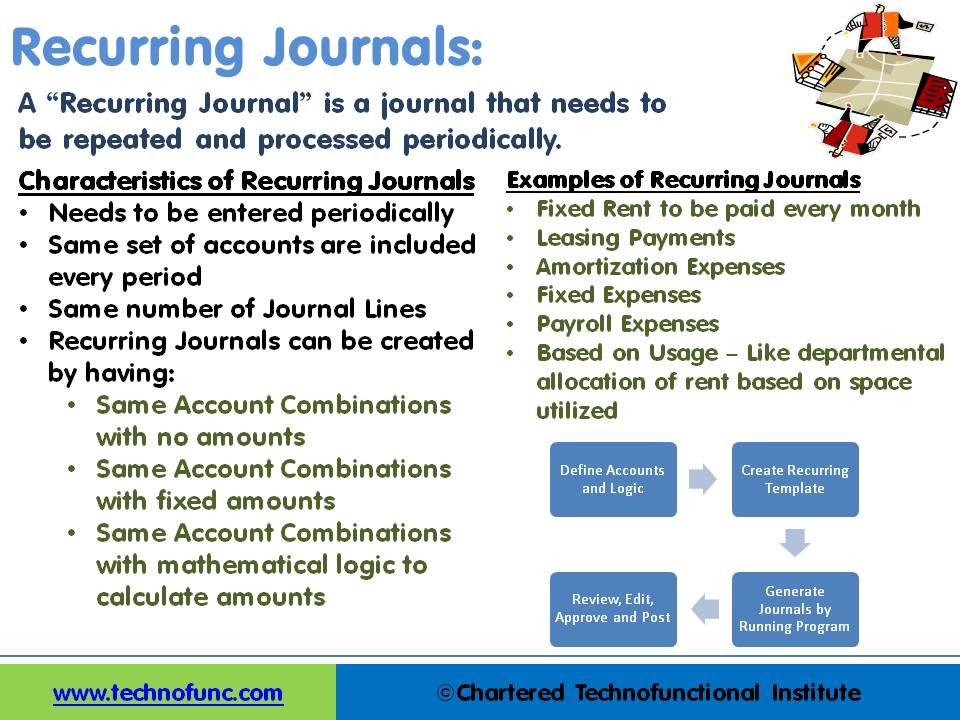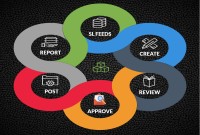- Home
- Business Processes
- Industry Knowledge
- Aerospace Industry
- Automotive Industry
- Banking Domain
- BFSI Industry
- Consumer/ FMCG Industry
- Chemicals Industry
- Engineering & Construction
- Energy Industry
- Education Domain
- Finance Domain
- Hospitality Domain
- Healthcare Industry
- Insurance Domain
- Retail Industry
- Travel and Tourism Domain
- Telecom Industry
- Leadership Skills
- eLearning
- Home
- Business Processes
- General Ledger (Record to Report)
- GL - Recurring Journal Entries
GL - Recurring Journal Entries
A “Recurring Journal” is a journal that needs to be repeated and processed periodically. Recurring Entries are business transactions that are repeated regularly, such as fixed rent or insurance to be paid every month. Learn the various methods that can be used to generate recurring journals. See some examples and explore the generic process to create recurring journals in any automated system.
What is a Recurring Journal?
A “Recurring Journal” is a journal that needs to be repeated and processed periodically. Recurring Entries are business transactions that are repeated regularly, such as fixed rent or insurance to be paid every month. Each accounting period the journal should have the same accounts but the amounts could be different. A recurring journal entry enables you to automate similar or repeating entries. For users who need to post certain transactions frequently with few or no changes, it is an advantage to use recurring journals.
Recurring entries allow for common repeatable transactions to be saved in a template and created in multiple accounting periods upon request, making it unnecessary to retype the entire transaction thereby improving productivity. The Auto-generation of recurring accounting entries minimizes the occurrence of errors and omissions. Systems allow the generation of recurring entries at weekly, monthly, or any other frequency.
Characteristics of Recurring Journals:
-
Needs to be entered periodically
-
The same set of accounts are included every period
-
The same number of Journal Lines
-
Logic exists to define the line selection criteria
-
Simplifies the process of recording repetitive journal entries
-
Creates same journal entries with varying or same amounts in different accounting periods
Methods to Create Recurring Journals:
1. Same Account Combinations with no amounts:
This is useful when the same accounts need to be used every period however the amounts get changed every time. In this scenario, the template is defined with no amounts, and amounts are entered manually every accounting period for which the entry needs to be generated.
2. Same Account Combinations with fixed amounts:
This is useful when both accounts and amounts can be pre-determined. A good example of this scenario is fixed rent payable each month on a specific date. In this case, the template is defined with actual amounts, and journals are created and posted for relevant accounting periods.
3. Same Account Combinations with mathematical logic to calculate amounts:
This is useful when accounts can be pre-determined and amounts will be based on some logic or pre-defined formula. A good example of this scenario could be defining salesmen accounts as the pre-determined accounts. The commission is to be paid to these salesmen as a fixed percentage of sales made by each salesman during the month and sales for each salesman are recorded in separate accounts. A recurring journal can be defined that can look for the balance in respective sales accounts at the end of the period and automatically calculate the commission and create the required accounting entry for commission payable.

Examples of Recurring Journals:
This method works best for repeatable transactions. For example annual expenses that can be charged through twelve equal monthly entries such as, rent or insurance expense allocation or annual lease rentals. Each month 1/12th of the total annual expense can be debited and credited to the appropriate accounts and appear as the current month’s actual transaction. Users can benefit by creating a recurring entry for some of the business scenarios listed below:
- Fixed Rent to be paid every month
- Fixed Insurance to be paid every month
- Leasing Payments
- Amortization Expenses
- Fixed Expenses
- Payroll Expenses
- Based on Usage – Like departmental allocation of rent based on space utilized
- Depreciation
- Allocations
Generic Process to Create Recurring Journals:
Users need to define recurring journal formulas for transactions that they want to repeat every accounting period, such as accruals, depreciation charges, and allocations. The formulas can be simple or complex but need to have some logic of ascertaining the amounts for each of the accounts that need to be repeated. Each formula can use fixed amounts and/or account balances and period-to-date or year-to-date balances from the current period, prior period, or same period last year. Given below is a generic process flow to define recurring journals:
- Define Accounts, Amounts or Formula or Logic
- Create Recurring Template
- Define the accounting periods for which the recurring journals need to be created
- Generate Journals by Running automated recurring journals creation program
- Enter missing data in case of Skelton journals – missing amounts
- Review, Edit, Approve and Post recurring journals
Allocations V/s Recurring Journals:
Recurring Journals are for transactions that repeat every accounting period as explained above and allocation Journals are for single journal entry using an accounting or mathematical formula to allocate revenues and expenses across a group of accounting dimensions like cost centers, departments, divisions, locations, or product lines depending upon usage factors.
Related Links
You May Also Like
-
When the quantum of business is expected to be moderate and the entrepreneur desires that the risk involved in the operation be shared, he or she may prefer a partnership. A partnership comes into existence when two or more persons agree to share the profits of a business, which they run together.
-
GL - Understanding Chart of Accounts
A chart of accounts (COA) is a list of the accounts used by a business entity to record and categorize financial transactions. COA has transitioned from the legacy accounts, capturing just the natural account, to modern-day multidimensional COA structures capturing all accounting dimensions pertaining to underlying data enabling a granular level of reporting. Learn more about the role of COA in modern accounting systems.
-
In this article, we will explain the general Ledger journal processing flow from entering journals to running the final financial reports. Understand the generic general ledger process flow as it happens in automated ERP systems. The accounting cycle explains the flow of converting raw accounting data to financial information whereas general ledger process flow explains how journals flow in the system.
-
In this article, we explain some commonly used subsidiary ledgers like accounts receivable subsidiary ledger, accounts payable subsidiary ledger or creditors' subsidiary ledger, inventory subsidiary ledger, fixed assets subsidiary ledger, projects subsidiary ledger, work in progress subsidiary ledger, and cash receipts or payments subsidiary ledger.
-
GL - Different Type of Journals
Two basic types of journals exist: general and special. In this article, the learner will understand the meaning of journalizing and the steps required to create a journal entry. This article will also discuss the types of journals and will help you understand general journals & special journals. In the end, we will explain the impact of automated ERPs on the Journalizing Process.
-
Hierarchical Organization Structures
Hierarchical structure is typical for larger businesses and organizations. It relies on having different levels of authority with a chain of command connecting multiple management levels within the organization. The decision-making process is typically formal and flows from the top down.
-
Horizontal or Flat Organizational Structures
Flat organizational structure is an organizational model with relatively few or no levels of middle management between the executives and the frontline employees. Its goal is to have as little hierarchy as possible between management and staff level employees. In a flat organizational structure, employees have increased involvement in the decision-making process.
-
Learn the typical accounting cycle that takes place in an automated accounting system. We will understand the perquisites for commencing the accounting cycle and the series of steps required to record transactions and convert them into financial reports. This accounting cycle is the standard repetitive process that is undertaken to record and report accounting.
-
Generally Accepted Accounting Principles define the accounting procedures, and understanding them is essential to producing accurate and meaningful records. In this article we emphasize on accounting principles and concepts so that the learner can understand the “why” of accounting which will help you gain an understanding of the full significance of accounting.
-
Functional Organizational Structures
A functional organizational structure is a structure that consists of activities such as coordination, supervision and task allocation. The organizational structure determines how the organization performs or operates. The term organizational structure refers to how the people in an organization are grouped and to whom they report.
Explore Our Free Training Articles or
Sign Up to Start With Our eLearning Courses

About Us
Learning
© 2023 TechnoFunc, All Rights Reserved










